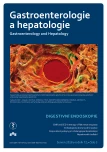Successful treatment of bleeding from aortoesophageal fistula with a metallic self-expandable stent
Authors:
E. Evinová 1; O. Urban 2; D. Kučera 3; P. Fojtík 1; J. Krátký 4; T. Málek 5; P. Falt 1
Authors‘ workplace:
Centrum péče o zažívací trakt, Vítkovická nemocnice a. s., Ostrava
1; II. interní klinika – gastroenterologie a geriatrie LF UP a FN Olomouc
2; Vaskulární centrum, Vítkovická nemocnice a. s., Ostrava
3; Radiologické oddělení, Vítkovická nemocnice a. s., Ostrava
4; Anesteziologicko-resuscitační oddělení, Vítkovická nemocnice a. s., Ostrava
5
Published in:
Gastroent Hepatol 2018; 72(3): 217-220
Category:
doi:
https://doi.org/10.14735/amgh2018217
Overview
We present a case of a 70-year-old patient diagnosed with acute bleeding from an aortoesophageal fistula, which was treated by endoscopic insertion of a self-expandable stent. Although the haemostasis was successful, the patient died from complications. Aortoesophageal fistula is a rare cause of upper gastrointestinal bleeding with high mortality and morbidity. Thoracic aortic aneurysm is the most common aetiology among other causes such as oesophageal carcinoma, foreign body ingestion, trauma or iatrogenic causes. It is an urgent condition that has often lethal consequences, especially due to a symptoms-free period followed by a massive haemorrhage. Nowadays, the diagnostic standard is computed tomography with angiography. The therapeutic solution consists in either a one-step (surgery) or two-step approach (endovascular treatment). However, the mortality from of aortoesophageal fistula is still high and requires multidisciplinary team collaboration to ensure a well-chosen therapeutic approach, and management of septic complications.
Key words:
aortoesophageal fistula – endoscopy – self-expandable metallic stent – gastrointestinal bleeding
The authors declare they have no potential conflicts of interest concerning drugs, products, or services used in the study.
The Editorial Board declares that the manuscript met the ICMJE „uniform requirements“ for biomedical papers.
Submitted: 13. 3. 2018
Accepted: 4. 6. 2018
Sources
1. Heckstall RL, Hollander JE. Aortoesophageal fistula: recognition and diagnosis in the emergency department. Ann Emerg Med October 1998; 32 (4): 502–505. doi: 10.1016/s0196-0644 (98) 70182-9.
2. Gomes SI, Campos FP, Martines BM et al. Primary aortoesophageal fistula: a rare cause of acute upper gastrointestinal bleeding. Autops Case Rep 2011; 1 (4): 57–63. doi: 10.4322/acr.2011.018.
3. Hollander JE, Quick G. Aortoesophageal fistula: a comprehensive review of the literature. Am J Med 1991; 91 (3): 279–287. doi: 10.1016/0002-9343 (91) 90129-L.
4. Lam EC, Brown JA, Whittaker JS. Esophageal foreign body causing direct aortic injury. Can J Gastroenterol 2003; 17 (2): 115–117.
5. Cairols, MA, Izquirdo LM, Barjau E et al. Primary aorto-oesophageal fistula due to oesophageal carcinoma. Report of a successfully managed case. Int Angiol 2000; 19 (3): 290–293.
6. Robbs JV, Bhoola KD. Aorto-oesophageal fistula complicating tuberculous aortitis. A case report. S Afr Med J 1976; 50 (18), 702–704.
7. Hance KA, Hsu J, Eskew T et al. Secondary aortoesophageal fistula after endoluminal exclusion because of thoracic aortic transection. J Vasc Surg 2003; 37 (4): 886–888. doi: 10.1067/mva.2003.159.
8. Baron RL, Koehler RE, Gutierrez FR et al. Clinical and radiographic manifestations of aortoesophageal fistulas. Radiology 1981; 141 (3): 599–605. doi: 10.1148/radiology.141.3.7302210.
9. Lukáš K, Žák A. Chorobné znaky a příznaky. Praha: Grada 2010.
10. Krška Z, Zavoral M. Krvácení do gastrointestinálního traktu. Praha: Triton 2007.
11. Tozzi di Angelo I, Malý T, Neoral Č et al. Neobvyklý případ krvácení ze zažívacího traktu. Čes a Slov Gastroent a Hepatol 2009; 63 (4): 177–178
12. Krajíček M, Peregrin H, Roček M et al. Chirurgická a intervenční léčba cévních onemocnění. Praha: Grada 2007: 149–152.
13. da Silva ES, Tozzi FL, Otochi JP et al. Aortoesophageal fistula caused by aneurysm of the thoracic aorta: successful surgical treatment, case report, and literature review. J Vasc Surg 1999; 30 (6): 1150–1157.
14. Omura A, Yoshida M, Koda Y et al. Surgical management without resection of the oesophagus for aorto-oesophageal fistula secondary to aortic arch aneurysm rupture. Interact Cardiovasc Thorac Surg 2016; 23 (6): 985–987. doi: 10.1093/icvts/ivw239.
15. da Silva ES, Tozzi FL, Otochi JP et al. Aortoesophageal fistula caused by aneurysm of the thoracic aorta: successful surgical treatment, case report, and literature review. J Vasc Surg 1999; 30 (6): 1150–1157.
Labels
Paediatric gastroenterology Gastroenterology and hepatology SurgeryArticle was published in
Gastroenterology and Hepatology

2018 Issue 3
Most read in this issue
- Vistaprep – the standard of bowel preparation before colonoscopy
- A tumorous atrioesophageal fistula as an unusual cause of septicemia
- Is Amanita phalloides poisoning still a problem?
- Experience in the treatment of severe bleeding in Crohn’s disease with anti-TNF therapy
